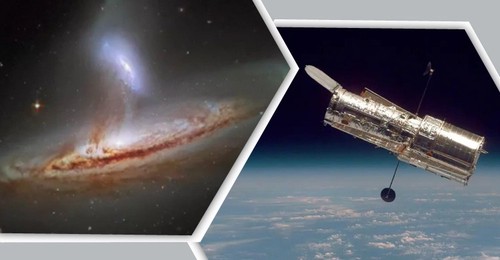
Millions of light years away from the earth, all the strange pictures attract everyone. Whether you are interested in astronomy or not. Pictures of space will amaze you in a moment. NASA's Hubble Space Telescope is a great telescope for framing these fascinating scenes from space.
It is difficult to find a scientist who does not know the name of Hubble Space Telescope. Anyone who has done a little research on astronomy must know about the Hubble Telescope. This time, the Hubble Space Telescope has taken an incredible picture of an incredible event that happened 32 crore light years away from the earth. It will take 320 million years to reach where the light travels from the earth.
Hubble made a clear three-dimensional picture of two galaxies decaying under gravity, so that the movements of the two galaxies were also captured. One of the galaxies is the Smaller Polar-Ring Galaxy IC 1559, the other is the Larger Spiral Galaxy NGC 189. The two galaxies together in the Atlas of Peculiar galaxy in Halton Arp are called ARP 262.
Hubble photographed an event in the Andromedo constellation. It is not uncommon for one galaxy to interact with another through gravity. However, it is difficult to get a clear picture of the interaction of two galaxies within three-dimensional space, where their movements are visible.
Coincidentally, this has been possible in the case of ARP 282. Hubble was at an angle at the right time. And that's why Hubble's cameras capture the movement of stars, the movement of dust and gas from one galaxy to another.
If the two galaxies had been tilted at another angle, perhaps this telescope would never have been able to take such a clear picture, where it would be possible for stars to fall from one galaxy to another.
Hubble also took the picture in visible light. NASA says the two galaxies, IC 1559 and NGC 189, have multiple black holes at least a hundred times larger than the Sun. The active galaxy also has a nucleus (AGN). Which emits large amounts of energy into the entire electromagnetic spectrum.
Astronomers now agree that the key to the evolution of a galaxy is how that galaxy interacts with other galaxies, a NASA official said in a statement.
One galaxy may merge with another, colliding with one another. Another galaxy can pass through another galaxy. The shape and structure of the galaxy will depend on these events.
Comments